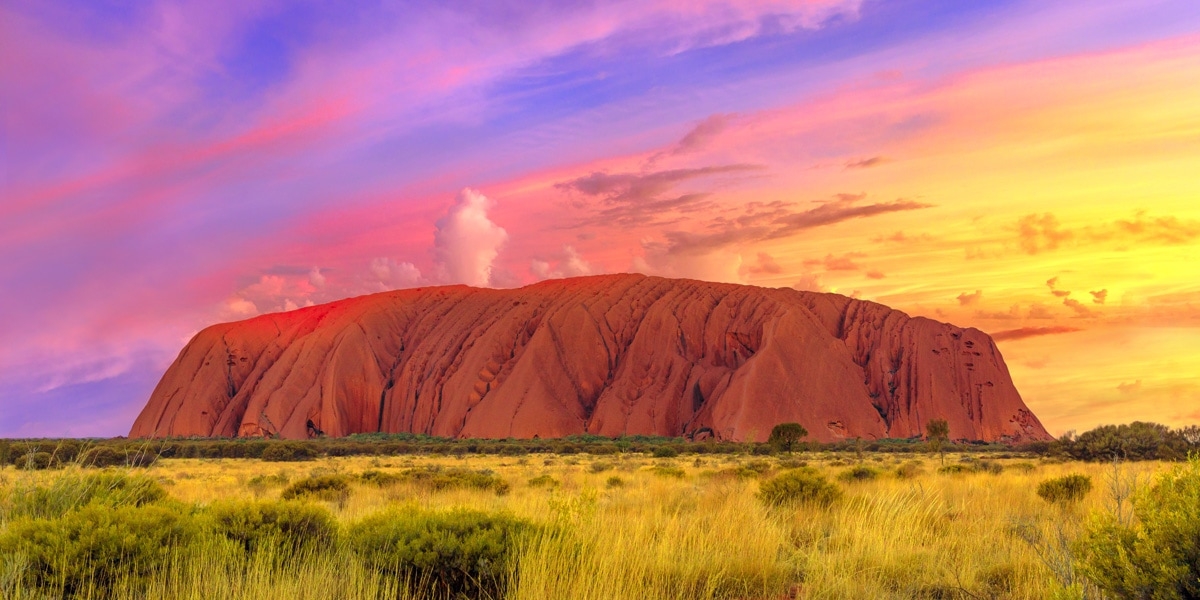
Uluru, also known as Ayers Rock, stands as a colossal sandstone monolith, a sacred icon, and a powerful symbol of Australia’s ancient and vibrant Indigenous culture. Rising majestically from the vast, arid plains of the Northern Territory’s Red Centre, this geological marvel captivates millions of visitors each year with its sheer scale, ever-changing colours, and profound spiritual significance. More than just a tourist destination, Uluru is a living entity, a place where the stories of the Anangu people, the traditional custodians, echo through the wind and the landscape. This comprehensive guide will delve into the fascinating facts surrounding Uluru, from its deep historical roots to practical advice for those embarking on a journey to this unforgettable destination.
A Chronicle Carved in Stone: The History of Uluru
The history of Uluru is intrinsically linked to the Anangu people, who have lived in this region for over 65,000 years. For them, Uluru is not merely a rock formation but a sacred site, a place where the Tjukurpa (Dreaming) – the ancestral beings and creation stories – are alive. The Anangu people believe that the landscape was shaped by the journeys and actions of these ancestral beings, and Uluru itself is a testament to their power and presence. Numerous Tjukurpa stories are associated with Uluru, depicting events like the battles of the Mala (rufous hare-wallaby) people, the Kuniya (diamond python) and Liru (poisonous snake) people, and the journey of the Wati Kutjarra (two male kangaroos). These stories are passed down through generations, woven into the art, songs, and ceremonies of the Anangu.
Related Articles about Uluru: A Monumental Majesty in the Heart of Australia:
- Manila: A Tapestry of History, Culture, and Urban Vibrancy
- Argentina: A Tapestry of Wonders – Unveiling its Best Tourist Attractions
- Kenya: A Timeless Tapestry of Wildlife, Culture, and Adventure – Your Ultimate Travel Guide
- Switzerland: The Ultimate Travel Guide to Alpine Majesty and Urban Charm
- Sweden: A Tapestry of Royal Grandeur, Natural Wonders, and Vibrant Culture
European discovery of Uluru is attributed to explorer William Gosse in 1873, who named it Ayers Rock in honour of Sir Henry Ayers, the then Chief Secretary of South Australia. For decades, the area was largely inaccessible, but as roads improved and interest grew, tourism began to develop. The creation of the Uluru-Kata Tjuta National Park in 1977 marked a significant step towards co-management with the Anangu people. In 1985, in a landmark moment, the title deeds to Uluru were handed back to the Anangu people, who then leased the park back to the Australian government for management. This dual ownership and management structure ensures the protection of both the cultural and natural heritage of Uluru.
The decision to ban climbing on Uluru, which came into effect in October 2019, was a profound and deeply significant moment. For the Anangu people, the climb was a source of great spiritual distress, as it was a sacred area not meant for human ascent. The ban reflects a growing global understanding of Indigenous rights and the importance of respecting sacred sites.
Main Attractions: More Than Just a Rock
While Uluru itself is the undeniable star of the show, the Uluru-Kata Tjuta National Park offers a wealth of experiences that extend far beyond the iconic monolith.
- Uluru Sunset and Sunrise: Witnessing the changing colours of Uluru as the sun rises and sets is a truly magical experience. The sandstone absorbs and reflects light, transforming from deep reds and oranges to purples and blues. Designated viewing areas provide the best vantage points for this daily spectacle.
- Base Walk (3.6 km, 2-3 hours): This relatively flat and accessible walk circles the base of Uluru, offering intimate views of its sheer scale and diverse geological features. Along the way, you’ll encounter ancient rock art sites, waterholes, and learn about the Tjukurpa stories associated with specific locations.
- Mala Walk (2 km, 1 hour): A guided walk that focuses on the Mala Tjukurpa, this experience provides deeper insights into Anangu culture and their ancestral connections to the land.
- Kuniya Walk (1 km, 40 minutes): This walk leads to Mutitjulu Waterhole, an important Anangu site, and is associated with the Kuniya and Liru Tjukurpa. The Aboriginal rock art here is particularly significant.
- Cultural Centre: The Uluru-Kata Tjuta Cultural Centre is an essential stop for understanding the Anangu people and their connection to the land. It features engaging exhibitions, displays of traditional art and artefacts, and opportunities to learn about Anangu culture and law.
- Kata Tjuta (The Olgas): A short drive from Uluru, Kata Tjuta is a collection of 36 massive domed rock formations, equally sacred to the Anangu. The Walpa Gorge walk (2.6 km return, 1-1.5 hours) winds through a narrow gorge between two of the domes, offering stunning views and a sense of the immense power of this landscape. The Valley of the Winds walk (7.4 km return, 3-4 hours) is a more challenging but incredibly rewarding circuit that takes you deep into the heart of Kata Tjuta.
- Field of Light: This immersive art installation by Bruce Munro features over 50,000 illuminated stems that create a breathtaking landscape of light around Uluru, particularly enchanting at night.
Travel Tips for an Unforgettable Journey
A trip to Uluru requires some planning to ensure a smooth and enriching experience.
- Book in Advance: Accommodation and tours, especially during peak seasons, can book out well in advance. It’s advisable to book your flights, accommodation, and any desired tours as early as possible.
- Stay Hydrated: The desert climate is extremely dry. Carry plenty of water with you at all times, especially when walking. Water refill stations are available in designated areas.
- Sun Protection: The Australian sun is intense. Wear a wide-brimmed hat, sunscreen with a high SPF, sunglasses, and light, long-sleeved clothing.
- Respect the Culture: Uluru is a sacred site. Be mindful of signage, avoid touching sacred sites, and always ask permission before taking photographs of people or their belongings. Embrace the opportunity to learn about Anangu culture respectfully.
- Footwear: Comfortable walking shoes are essential for exploring the park.
- Insect Repellent: Mosquitoes and flies can be present, especially at dawn and dusk.
- Pack Layers: Temperatures can fluctuate significantly between day and night, so pack layers of clothing.
- Embrace the Silence: Beyond the visual spectacle, take time to absorb the profound silence and vastness of the desert. It’s an experience that can be deeply restorative.
Best Time to Visit: Embracing the Seasons
The Red Centre experiences distinct seasons, each offering a unique perspective on Uluru.
- Autumn (March to May): This is arguably the most popular time to visit. Temperatures are mild and pleasant, with daytime highs averaging around 25-30°C. The skies are often clear, and the landscape is usually a vibrant red.
- Winter (June to August): While cooler, winter offers clear skies and comfortable daytime temperatures, typically ranging from 18-25°C. Evenings can be chilly, dropping to near freezing, so warm clothing is essential. This is an excellent time for walking and exploring.
- Spring (September to November): Similar to autumn, spring offers pleasant temperatures, but it can start to heat up towards November. Wildflowers may bloom after any rainfall, adding a splash of colour to the landscape.
- Summer (December to February): Summers are very hot, with daytime temperatures frequently exceeding 40°C. While the landscape is stunning, it can be challenging to do extensive walking. However, summer often brings spectacular thunderstorms, which can create dramatic skies and a sense of renewal.
Nearby Hotels: Comfort in the Outback
Accommodation options are primarily located in and around Yulara, a purpose-built resort town just outside the national park entrance.
- Sails in the Desert: A premium hotel offering luxurious rooms, stunning views of Uluru, and excellent dining options.
- The Lost Camel Hotel: A stylish and contemporary hotel with a more boutique feel, offering comfortable rooms and a relaxed atmosphere.
- Desert Gardens Hotel: Offers a range of rooms with balconies and views of the desert landscape.
- Outback Pioneer Lodge: A more budget-friendly option, providing a range of accommodation from dorm rooms to private cabins, and a lively atmosphere.
- Ayers Rock Campground: For those who prefer camping, this well-equipped campground offers powered and unpowered sites.
It’s important to note that accommodation prices in Yulara can be higher than in other parts of Australia due to the remote location.
Local Food: A Taste of the Outback
The culinary scene in Yulara offers a blend of Australian flavours and international cuisine, with an increasing focus on incorporating native ingredients.
- Bush Tucker: While not as readily available as in urban centers, some restaurants offer dishes featuring native ingredients like kangaroo, emu, and quandongs (a native fruit). Look for menus that highlight these unique flavours.
- Australian Classics: Expect to find classic Australian fare such as grilled meats, seafood, and hearty pub-style meals.
- International Cuisine: The hotels in Yulara offer a range of dining experiences, including Italian, Asian, and buffet-style restaurants, catering to diverse palates.
- Picnics: Consider packing your own snacks and picnic supplies for lunches during your explorations within the park. Many of the hotels and the general store in Yulara offer provisions.
Transportation Options: Reaching the Red Centre
Getting to Uluru requires a bit of planning due to its remote location.
- By Air: The most convenient way to reach Uluru is by flying into Ayers Rock Airport (Connellan Airport – AYQ) in Yulara. Major Australian airlines operate flights from Sydney, Melbourne, Brisbane, and Cairns. From the airport, shuttle buses or taxis are available to take you to your accommodation.
- By Car: Driving to Uluru is a significant undertaking. It’s a long journey from major cities, often requiring overnight stops. The Stuart Highway is the main route. Driving offers flexibility but requires careful planning, especially regarding fuel stops and vehicle suitability for outback conditions.
- By Coach: Several coach companies offer services to Uluru from Alice Springs and other regional centres. This is a more budget-friendly option but takes longer than flying.
- Within the Park: Once you are in Yulara, most visitors utilize the free shuttle bus service that connects the accommodation, the Cultural Centre, and the various viewing and walking areas within the Uluru-Kata Tjuta National Park. Car hire is also available for those who prefer to explore at their own pace.
In conclusion, Uluru is a destination that transcends mere sightseeing. It’s an immersion into an ancient land, a profound connection with a living culture, and a humbling encounter with the raw power of nature. By understanding its history, respecting its sacredness, and planning your visit with care, you will undoubtedly be captivated by the monumental majesty of Uluru, an experience that will resonate long after you depart the Red Centre.







